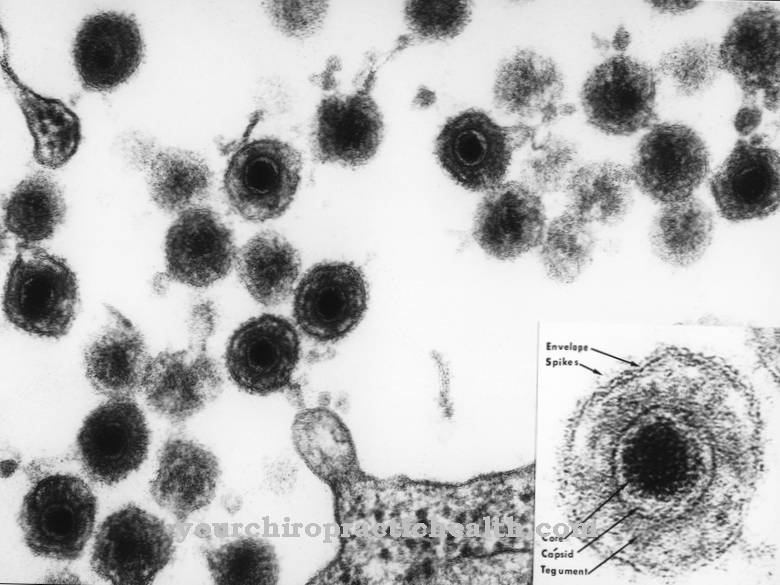Colds are one of the most common infectious diseases. In poorer countries they are high on the list of causes of death. It's the tiny ones to blame Rhinovirusesthat have special properties.
What are rhinoviruses?
Rhinoviruses are RNA viruses that, unlike other viruses, do not have a lipid envelope. They have an icosahedral shape. Each of the 20 areas has a depression in its center to which the receptor protein binds. The outer capsid layer consists of a protein that does not allow the formation of antibodies outside the virus.
Rhinoviruses belong to the picorna viruses and specialize in colds and respiratory infections in humans and monkeys. They replicate particularly quickly at temperatures between 3 and 33 degrees Celsius. This is why the cold pathogen finds ideal conditions to multiply in cold, wet weather.
Around 110 subtypes of the rhinoviruses have now been identified. They can be divided into three classes (Rhinovirus A, B and C). The tiny virus that causes colds, coughs, hoarseness, sore throats and respiratory infections can be detected using the PCR test and forms virus proteins that consist of 2,200 amino acids. In a second step, these are broken down into the corresponding proteins with the help of two proteases (enzymes that break down proteins). People who have come into contact with different virus strains several times can suppress their cold more quickly than people who have not.
Occurrence, Distribution & Properties
Rhinoviruses consist of a 20-sided capsid and have a diameter of 24 to 30 nanometers. They are thermally stable, but sensitive to acids, substances containing alkyl and physical disinfection methods. Their single-stranded RNA is 7,200 to 8,500 base pairs in length and positive polarity. All three rhinovirus strains cause similar disease symptoms, although they show only relatively little molecular similarity.
Only humans and monkeys can become infected with the pathogen. After penetrating the epithelia, they cause only minor tissue damage, but completely destroy the host cell when they exit. All types of chemokines react to infection with the pathogen. These are signal proteins that indicate to the immune system that it should produce increased numbers of granulocytes and T cells to fight the virus.
People who were infected with rhinoviruses multiple times in their childhood and who responded with shortness of breath are at higher risk of developing asthma in adulthood.
Rhinoviruses occur in at least 110 subtypes worldwide. Therefore, it is impossible to fight them with a single vaccine. The subtypes are categorized as rhinovirus classes A, B and C because of their serological properties. The rhinovirus C, which was only discovered in 2009, is currently being scientifically investigated.
Rhinoviruses occur more frequently in the winter months and in late summer. Types A and B use 90% of the ICAM I receptor for reproduction. 10% of the subtypes penetrate the host cells via the receptor for LDL cholesterol. Which input type C uses has not yet been clarified.
Rhinoviruses multiply preferentially at temperatures below 33 degrees in the upper and lower respiratory organs (bronchi, lungs). After entering the host cell, the virus replicates its RNA in the endoplasmic reticulum using the RNA polymerase 3DPol. When it leaves the cell, it destroys it.
A new propagation cycle is started every 12 hours. Rhinoviruses spread via droplets (sneezing, coughing). A single sneeze throws millions of them into the air at around 160 km / h. Those affected are often infected via a smear infection (infected door handles, shaking hands, wiping eyes, etc.).The incubation period is between a few hours and 3 days. The pathogens can be infectious for a long time, depending on the environmental conditions. The cold can shed it until the disease has healed (sometimes up to 3 weeks).
Illnesses & ailments
Rhinoviruses first penetrate the nose and infect the epithelial cells of the nasal mucosa. The sick person gets a cold. They move on to the oropharynx (sore throat, angina, hoarseness) and then to the bronchi and lungs, where they can cause coughs, asthma and COPD attacks, bronchitis and, in children and people with immunodeficiency, bronchopneumonia. In severe cases, rhinovirus infestation can even lead to life-threatening shortness of breath.
Although these viruses are not the only pathogens that cause colds, 2/3 of all colds are caused by them. In people with an underlying condition such as bronchial asthma, they make the underlying condition worse. Because of the many subtypes, humans can only develop resistance to those of them with whom their body has already had contact.
Babies and children are particularly at risk because their immune systems are not yet fully developed. Therapy is often symptomatic with cold remedies, nasal ointments, cough medication and inhalation. The homeopathic remedy pelargonium relieves bronchitis symptoms, sage helps with sore throats. Some home remedies also provide relief and can help strengthen the body and immune system.
The administration of antibiotics only makes sense if there is a superinfection at the same time and a bacterial infection has developed in addition to the viral infection. Frequent hand washing and avoidance of large crowds during the cold season help prevent rhinovirus infections. Homeopathic Echinacea strengthens the immune system. Vitamin C and zinc can be used preventively and therapeutically against rhinoviruses.
























.jpg)



